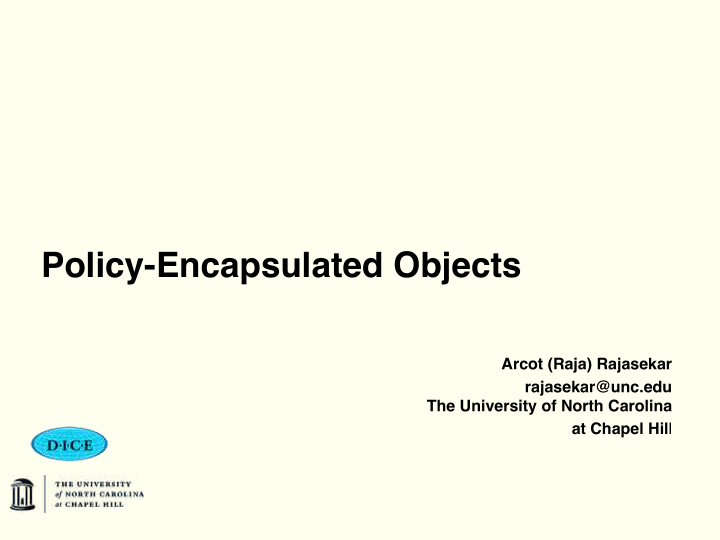



Policy-Encapsulated Objects Arcot (Raja) Rajasekar rajasekar@unc.edu The University of North Carolina at Chapel Hil l
Outline • Motivations • Anatomy of PEOs • Architectural Issues • Q&A Acknowledgement: Prof. Reagan Moore and I had discussions about PEOs around 4 or 5 years back but never got around to doing anything about them. Reagan is part of the intellectual genealogy of the PEOs. CoreGen3
iRODS What does iRODS bring to the table? – Federated virtual dataspace (also other spaces: userspace/resources/…) – Rich Metadata Discovery System – Extensible System Information (ACLs, Audits,…) – Distributed Data Pipelines – User-tunable workflows & µ -services FAIR Data Principles – Distributed Rule Engine Findability – Etc., Etc., … Accessibility Interoperability Reusability Extensible Big Data Life Cycle Management
What is Missing? • Portability beyond iRODS • Chain of Custody beyond iRODS iRODS looses control when a dataset is taken out its zone X What is lost: – Continuous Integrity Maintenance – Continuous Authorization & Authentication FAIR Data – Continuous Auditing Principles – Continuous Versioning, Edit control Findability – Linkages with Metadata – (user, system, …) Accessibility – Linkages with ACLS, Workflows, Pipelines, µ -services, … Interoperability Reusability – Things are good as long as they are inside iRODS – Move it out or even out of a zone to another, What is we loose control – Dangling data lifecycle Needed? – This is true not just for iRODS but also any storage system Extraterritorial jurisdiction (ETJ) is the legal ability of a ET the extraterrestrial, government to exercise authority beyond its normal boundaries. 1982, Universal Studios
Power up!! • Answer: Make a data object to be active • Now data objects are passive – They have no control over what happens to them, – Where can they be stored – Which application can handle them, – Which user can view them, • All actions on an object controlled by outside entities and processes – even inside iRODS GIVE POWER TO DATA OBJECTS –> FREE THE DATA Give them Independence to control their destiny Give them Policies and Set them free
What is a Policy Encapsulated Object? INTERPRETER POLICIES & SERVICES METADATA DATA The idea is not new but it is novel From Docker:. A container is a standard unit of software that packages up code and all its dependencies so the PEO application runs quickly and reliably from one computing environment to another. A Docker container image is a lightweight, standalone, executable package of software that
PEO = Trusted Data • Live Data Object • Trust & Integrity – Reproducibility – Trusted Environment • Trust goes both ways • Self-containment – Portability – Independence • Chain of Custody – FAIR Data Principles – Full Data Life-cycle Compliance
Types of POE • Tethered POE – Checks back to Home Zone – Home Zone can update and recall!! – Change Policy – Yank ACLs!! – Audit Trail & Remote Editing can be synchronized – Kill from far!! • Autonomous PEO – Simpler – Self-reliant
Architecture • Active Data Architecture – Active Policies (Execute on Event) – Apply policies when they mature • Event-driven or Periodic • Message-based Architecture • Event-based Architecture • Rule Interpreter Engine – Failure Action or Recovery
Open/Query Data Operational Data Architecture Unpack 4 PEO & 9 Apply Policy Data Transfer 10 Homebase Data & metadata PEO Policy 1 Check 7 5 Ingest 6 8 PEO Local Policy Check Remote Computer 2 PEO Creation 3 PEO PEO Transfer iRODS Zone Sentinel
Use Cases – Security – Privacy – Autonomy – Automation – Compliance – Fidelity – Tight beam data transfer – Integration with Blockchain
Q & A rajasekar@unc.edu
Recommend
More recommend